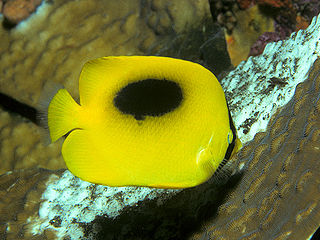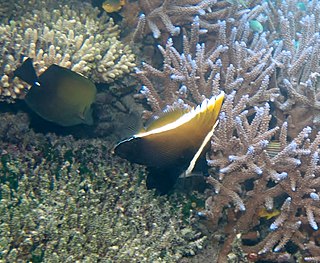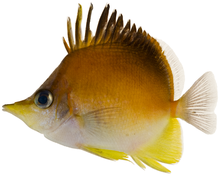
The butterflyfish are a group of conspicuous tropical marine fish of the family Chaetodontidae; the bannerfish and coralfish are also included in this group. The approximately 129 species in 12 genera are found mostly on the reefs of the Atlantic, Indian, and Pacific Oceans. A number of species pairs occur in the Indian and Pacific Oceans, members of the huge genus Chaetodon.

Chaetodon is a tropical fish genus in the family Chaetodontidae. Like their relatives, they are known as "butterflyfish". This genus is by far the largest among the Chaetodontidae, with about 90 living species included here, though most might warrant recognition as distinct genera.

The reef butterflyfish. also known as the least butterflyfish, Atlantic butterflyfish, butterbun or school mistress, is a species of marine ray-finned fish, a butterflyfish of the family Chaetodontidae. It is found in the western Atlantic Ocean.

Pontinus is a genus of marine ray-finned fish belonging to the family Scorpaenidae, the scorpionfishes. The scorpionfishes in this genus are distributed in the tropical and warm temperate parts Atlantic, Indian and Pacific Oceans.

The raccoon butterflyfish, also known as the crescent-masked butterflyfish, lunule butterflyfish, halfmoon butterflyfish, moon butterflyfish, raccoon butterfly, raccoon, raccoon coralfish, and redstriped butterflyfish, is a species of marine ray-finned fish, a butterflyfish belonging to the family Chaetodontidae. It is found in the Indian and Pacific Oceans.

The ornate butterflyfish, or clown butterflyfish is a species of marine ray-finned fish, a butterflyfish in the family Chaetodontidae.

Prognathodes is a genus of butterflyfish in the family Chaetodontidae. They are found at rocky reefs in tropical oceans around the world and are mainly found deeper than Chaetodon; often a depths below those possible in normal scuba diving. In the past they were commonly included in the genus Chaetodon. They are whitish, yellow, black and dark brown, and reach 10–16 centimetres (3.9–6.3 in) in length.

The slippery dick is a species of wrasse native to shallow, tropical waters of the western Atlantic Ocean.

The blacktail butterflyfish, also known as black-tailed butterflyfish or exquisite butterflyfish, is a species marine ray-finned fish, a butterflyfish belonging to the family Chaetodontidae. It is native to the western Indian Ocean but has reached the Mediterranean Sea as a Lessepsian migrant through the Suez Canal.

The lined butterflyfish is a species of marine ray-finned fish. a butterflyfish belonging to the family Chaetodontidae, one of the largest species in the genus Chaetodon. It has a wide range from the Red Sea to South Africa and as far east as southern Japan and Hawaii.

The black-backed butterflyfish or blackback butterflyfish is a species of butterflyfish. It is widespread through the Indo-Pacific area from the Red Sea and East Africa to Samoa, to southern Japan and throughout Micronesia.

The bank butterflyfish is a species of marine ray-finned fish, a butterflyfish belonging to the family Chaetodontidae. It is found in tropical and sub-tropical waters of the western Atlantic Ocean.

The mirror butterflyfish or oval-spot butterflyfish is a species of butterflyfish. It is found in the Indo-Pacific region from Indonesia to Japan and south to the Great Barrier Reef and Papua New Guinea. The species has also been reported from Madagascar, Mauritius and Réunion.

The Spot-naped Butterflyfish, also known as the pig-face butterflyfish, is a species of marine ray-finned fish. a butterflyfish belonging to the family Chaetodontidae. It is found in the Indo- West Pacific region from Sri Lanka to Queensland, north to Indonesia and the Philippines.

Parachaetodon is a monotypic genus of butterflyfishes, the only species being the sixspine butterflyfish, which is also known as the ocellate butterflyfish or eyespot butterflyfish. is a species of butterflyfish native to tropical reefs of the eastern Indian Ocean and the western Pacific Ocean.

Haemulon vittatum, the boga, is an ocean-going species of grunt native to the western Atlantic Ocean. Bogas are also known as the snit in Jamaica, and bonnetmouth in the Bahamas. It was first described by Cuban zoologist Felipe Poey. This species used to be classified as Inermia vittata, but genetic data revealed that it belongs to the genus Haemulon.
Emmelichthyops atlanticus, the bonnetmouth, is a marine fish species of grunt native to the western Atlantic Ocean, where it occurs from Florida and the Bahamas to northern South America. This species is the only known member of its genus.

The Black Butterflyfish, also known as the dusky butterflyfish, is a species of marine ray-finnedfish, a butterflyfish belonging to the family Chaetodontidae. It is native to the Pacific Ocean.
Prognathodes carlhubbsi, the southern scythemarked butterflyfish or southern scythe butterflyfish, is a species of butterflyfish found at rocky reefs in the tropical Eastern Pacific, where found at depths of 12–270 metres (39–886 ft) at the Galápagos Islands, Cocos Island, Malpelo Island, and off northwestern Peru. Until P. carlhubbsi was described as a separate species in 1995, populations in these regions were included in P. falcifer. When separated, the true P. falcifer is restricted to more northernly regions, and it has whitish-grey belly and flanks, the black line through the eye is paler and less distinct, and the angle of the inverted black "V" on the side is shallower.

Heniochus varius, the horned bannerfish or humphead bannerfish, is a species of marine ray-finned fish, a butterflyfish belonging to the family Chaetodontidae, native from the central Indo-Pacific area.





















